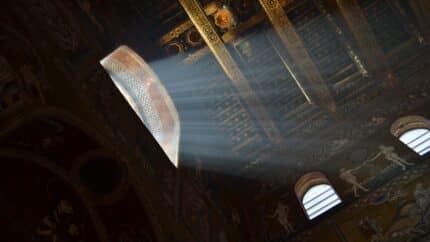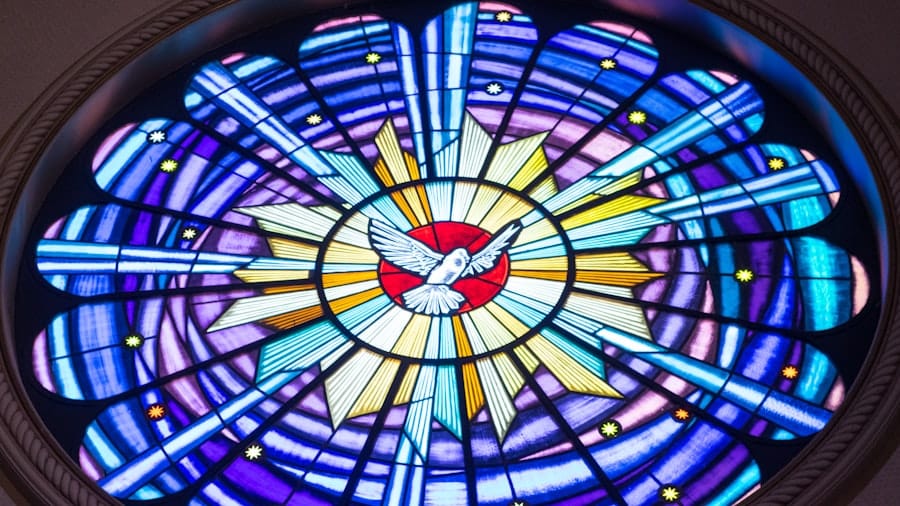The Holy Grail: Searching for the Cup of Christ

The Holy Grail has been a subject of fascination and mystery for centuries. It is a symbol of spiritual and physical quest, representing the ultimate goal or prize that one seeks. The concept of the Holy Grail has permeated literature, art, and mythology, capturing the imagination of people from all walks of life.
The Origins of the Holy Grail Legend
The legend of the Holy Grail has its roots in Celtic and Christian mythology. In Celtic mythology, there is a tradition of a sacred vessel that provides nourishment and healing. This concept was later adopted by Christianity, where the Holy Grail became associated with the cup used by Jesus at the Last Supper.
The idea of a sacred vessel that holds great power and significance is not unique to Celtic and Christian mythology. Similar concepts can be found in various cultures around the world. For example, in Hinduism, there is the concept of the Amrita, a divine nectar that grants immortality. In Norse mythology, there is the Mead of Poetry, which bestows wisdom and inspiration upon those who drink it.
The Role of Ancient Mystery in the Holy Grail Quest
The quest for the Holy Grail is often associated with ancient mystery traditions. These traditions involve hidden knowledge or secret wisdom that can only be attained through a spiritual journey. The idea of embarking on a quest to uncover this hidden knowledge is a common theme in many ancient cultures.
The quest for the Holy Grail can be seen as a metaphor for the spiritual journey that individuals undertake in their search for meaning and purpose in life. It represents the desire to uncover hidden truths and attain spiritual enlightenment. This theme has resonated with people throughout history, as they seek answers to life’s deepest questions.
The Grail Quest in Literature and Art
The legend of the Holy Grail has been depicted in numerous works of literature and art. From medieval romances to modern novels, the quest for the Grail has captured the imagination of writers and artists alike.
One of the most famous depictions of the Holy Grail is found in Sir Thomas Malory’s Le Morte d’Arthur. In this epic tale, King Arthur and his knights embark on a quest to find the Holy Grail, which is said to have the power to heal all wounds and bring about eternal life. The story explores themes of chivalry, honor, and the search for spiritual enlightenment.
In addition to literature, the Holy Grail has also been a popular subject in art. Paintings and sculptures depicting the Grail have been created by artists such as Leonardo da Vinci, Raphael, and Salvador Dali. These works often portray the Grail as a beautiful and mysterious object, surrounded by an aura of divine light.
The Knights Templar and the Holy Grail
The Knights Templar have long been linked to the Holy Grail legend. The Templars were a medieval Christian military order that gained great wealth and power during the Crusades. Some believe that they discovered the Holy Grail during their time in the Holy Land.
According to legend, the Templars were entrusted with guarding the Holy Grail and other sacred relics. They were said to have brought these relics back to Europe, where they were hidden away in secret locations. This has led to speculation that the Templars may have had knowledge of the true nature and whereabouts of the Holy Grail.
While there is no concrete evidence to support these claims, they have captured the imagination of many people. The idea of a secret society guarding ancient relics and possessing hidden knowledge is an intriguing one, and it has fueled countless conspiracy theories and works of fiction.
The Grail and Christianity: The Cup of Christ
In Christian mythology, the Holy Grail is often associated with the cup used by Jesus at the Last Supper. According to the New Testament, Jesus took a cup of wine and said, “This is my blood of the covenant, which is poured out for many for the forgiveness of sins.” This act is seen as the institution of the Eucharist, a central sacrament in Christianity.
The idea of a sacred vessel that holds the blood of Christ has been a powerful symbol in Christian mythology. It represents the divine presence and sacrifice of Jesus, and it is believed to have the power to heal and bring about spiritual transformation.
The Holy Grail is often depicted as a chalice or cup, adorned with precious jewels and symbols of divinity. It is said to possess miraculous powers, such as the ability to heal the sick and grant eternal life. In this way, it serves as a physical representation of God’s grace and mercy.
The Grail and Pagan Mythology: The Cauldron of Plenty
The concept of a magical cauldron that provides abundance and fertility is common in pagan mythology. In Celtic mythology, for example, there is the Cauldron of Plenty, also known as the Cauldron of Dagda. This cauldron has the power to provide an endless supply of food and drink.
The Grail legend may have been influenced by these earlier myths and legends. The idea of a sacred vessel that provides nourishment and healing can be seen as a continuation of the ancient belief in the power of the cauldron.
In addition to Celtic mythology, similar concepts can be found in other pagan traditions. For example, in Norse mythology, there is the story of Óðinn stealing the Mead of Poetry from the giants. This mead grants wisdom and inspiration to those who drink it, much like the Holy Grail in Christian mythology.
The Grail and Arthurian Legend: King Arthur’s Quest
The story of King Arthur and his knights is closely linked to the Holy Grail legend. In Arthurian legend, the quest for the Holy Grail is seen as the ultimate test of a knight’s worthiness and virtue. Only the purest and most noble of knights can hope to find the Grail and achieve spiritual enlightenment.
The quest for the Holy Grail is often seen as a metaphor for the spiritual journey of the knights. It represents their search for meaning and purpose in life, as well as their desire to attain spiritual enlightenment. The knights must overcome various challenges and temptations along the way, testing their courage, loyalty, and integrity.
The story of King Arthur and the Holy Grail has been told and retold in countless works of literature, from medieval romances to modern novels. Each retelling adds its own unique twist to the legend, but the central themes of honor, chivalry, and the search for spiritual enlightenment remain constant.
The Search for the Real Holy Grail: Historical and Archaeological Evidence
Despite the many legends and myths surrounding the Holy Grail, there is little concrete evidence of its existence. The Grail remains a symbol of mystery and intrigue, with its true nature and whereabouts remaining unknown.
Some historians and archaeologists have attempted to uncover the truth behind the legend. They have searched for physical evidence of the Holy Grail, such as ancient cups or chalices that could potentially be linked to Jesus or other historical figures.
One of the most famous claims regarding the Holy Grail is that it is housed in the Cathedral of Valencia in Spain. The artifact in question is a medieval agate dish known as the Holy Chalice. While there is no definitive proof that this dish is indeed the Holy Grail, it has been venerated as such by many people throughout history.
Other theories suggest that the Holy Grail may be hidden in various locations around the world, such as the Rosslyn Chapel in Scotland or the Temple Mount in Jerusalem. These theories are often based on historical and archaeological evidence, as well as legends and folklore.
The Legacy of the Holy Grail: Modern Interpretations and Symbolism
The Holy Grail continues to be a powerful symbol in modern culture. It has inspired countless works of literature, art, and film, and it remains a popular theme in popular culture.
In recent years, the Holy Grail has been depicted in movies such as “Indiana Jones and the Last Crusade” and “The Da Vinci Code.” These films explore the idea of a hidden treasure or secret knowledge that can only be attained through a perilous journey.
The Grail quest also remains a popular theme in video games and comic books. Many games and comics feature characters embarking on a quest to find the Holy Grail, battling enemies and solving puzzles along the way.
In conclusion, the Holy Grail is a symbol of spiritual and physical quest that has captivated people for centuries. Its origins can be traced back to Celtic and Christian mythology, as well as other ancient mystery traditions. The legend of the Holy Grail has been depicted in numerous works of literature and art, and it continues to inspire modern interpretations and symbolism. While there is little concrete evidence of its existence, the Holy Grail remains a powerful symbol of mystery and intrigue.
FAQs
What is the Holy Grail?
The Holy Grail is a legendary cup or chalice that is said to have been used by Jesus Christ during the Last Supper. It is believed to have miraculous powers and is considered one of the most sought-after relics in Christianity.
What is the history of the Holy Grail?
The history of the Holy Grail is shrouded in mystery and legend. It is believed to have been brought to Britain by Joseph of Arimathea, who was said to have collected the blood of Jesus in the cup after his crucifixion. The story of the Holy Grail gained popularity during the Middle Ages and has been the subject of many literary works and legends.
What is the significance of the Holy Grail?
The Holy Grail is considered a symbol of purity, divinity, and spiritual enlightenment. It is believed to have the power to heal and grant eternal life. The search for the Holy Grail has been a quest for many people throughout history, representing the pursuit of spiritual fulfillment and enlightenment.
Has the Holy Grail ever been found?
There is no concrete evidence that the Holy Grail has ever been found. Many legends and stories exist about its whereabouts, but none have been proven to be true. Some believe that the Holy Grail is still hidden somewhere, waiting to be discovered.
What are some of the theories about the location of the Holy Grail?
There are many theories about the location of the Holy Grail, ranging from the possibility that it is buried beneath Rosslyn Chapel in Scotland to the idea that it was taken to America by the Knights Templar. Some believe that the Holy Grail is hidden in a secret location, while others think that it was destroyed or lost over time.
Why is the search for the Holy Grail important?
The search for the Holy Grail is important because it represents the human quest for spiritual fulfillment and enlightenment. It is a symbol of hope and faith, and the search for it has inspired many people throughout history to pursue their own spiritual journeys. Additionally, the Holy Grail is an important part of Christian mythology and has played a significant role in many literary works and legends.
Leave A Reply
You must be logged in to post a comment.










 Paranormal
Paranormal

